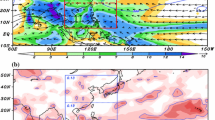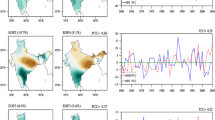Abstract
The interannual variation of East Asia summer monsoon (EASM) rainfall exhibits considerable differences between early summer [May–June (MJ)] and peak summer [July–August (JA)]. The present study focuses on peak summer. During JA, the mean ridge line of the western Pacific subtropical High (WPSH) divides EASM domain into two sub-domains: the tropical EA (5°N–26.5°N) and subtropical-extratropical EA (26.5°N–50°N). Since the major variability patterns in the two sub-domains and their origins are substantially different, the Part I of this study concentrates on the tropical EA or Southeast Asia (SEA). We apply the predictable mode analysis approach to explore the predictability and prediction of the SEA peak summer rainfall. Four principal modes of interannual rainfall variability during 1979–2013 are identified by EOF analysis: (1) the WPSH-dipole sea surface temperature (SST) feedback mode in the Northern Indo-western Pacific warm pool associated with the decay of eastern Pacific El Niño/Southern Oscillation (ENSO), (2) the central Pacific-ENSO mode, (3) the Maritime continent SST-Australian High coupled mode, which is sustained by a positive feedback between anomalous Australian high and sea surface temperature anomalies (SSTA) over Indian Ocean, and (4) the ENSO developing mode. Based on understanding of the sources of the predictability for each mode, a set of physics-based empirical (P-E) models is established for prediction of the first four leading principal components (PCs). All predictors are selected from either persistent atmospheric lower boundary anomalies from March to June or the tendency from spring to early summer. We show that these four modes can be predicted reasonably well by the P-E models, thus they are identified as the predictable modes. Using the predicted PCs and the corresponding observed spatial patterns, we have made a 35-year cross-validated hindcast, setting up a bench mark for dynamic models’ predictions. The P-E hindcast prediction skill represented by domain-averaged temporal correlation coefficient is 0.44, which is twice higher than the skill of the current dynamical hindcast, suggesting that the dynamical models have large rooms to improve. The maximum potential attainable prediction skills for the peak summer SEA rainfall is also estimated and discussed by using the PMA. High predictability regions are found over several climatological rainfall centers like Indo-China peninsula, southern coast of China, southeastern SCS, and Philippine Sea.








Similar content being viewed by others
References
Chang CP, Zhang Y, Li T (2000) Interannual and interdecadal variations of the East Asian summer monsoon and tropical Pacific SSTs. Part I: roles of the subtropical ridge. J Clim 13:4310–4325
Chen TJG, Chang CP (1980) The structure and vorticity budget of an early summer monsoon trough (Mei–Yu) over southeastern China and Japan. Mon Wea Rev 108:942–953
Dee DP et al (2011) The ERA-interim reanalysis: configuration and performance of the data assimilation system. Q J R Meteorol Soc 137:553–597
Delworth TL, Broccoli AJ, Rosati A et al (2006) GFDL’s CM2 global coupled climate models. Part I: formulation and simulation characteristics. J Clim 19:643–674
Ding YH (1992) Summer monsoon rainfalls in China. J Meteor Soc Jpn 70:397–421
Ding YH, Chan JCL (2005) The East Asian summer monsoon: an overview. Meteorol Atmos Phys 89:117–142
Fan K, Liu Y, Chen HP (2012) Improving the prediction of the East Asian summer monsoon: new approaches. Weather Forecast 27(4):1017–1030
He JH, Wu ZW, Jiang ZH, Miao CS, Han GR (2007) “Climate effect” of the northeast cold vortex and its influences on Meiyu. Chin Sci Bull 52(5):671–679
Hudson D, Alves O, Hendon HH, Wang G (2010) The impact of atmospheric initialisation on seasonal prediction of tropical Pacific SST. Clim Dyn 36:1155–1171
Huffman GJ, Bolvin DT, Adler RF (2011) Last updated GPCP Version 2.2 combined precipitation data set. WDC-A, NCDC, Asheville, NC (2011). Dataset Accessed at http://www.ncdc.noaa.gov/oa/wmo/wdcamet-ncdc.html
Kao HY, Yu JY (2009) Contrasting eastern-Pacific and central Pacific types of El Niño. J Clim 22:615–632
Kosaka Y, Yang S (1997) Climatology and interannual variability of the Southeast Asian summer monsoon. Adv in Atmos. Sci. 14(2):141–162
Lau KM, Yang GJ, Shen H (1988) Seasonal and intraseasonal climatology of summer monsoon rainfall over East Asia. Mon Wea Rev 116(1):18–37
Lau NC, Nath MJ, Wang H (2004) Simulations by a GFDL GCM of ENSO-related variability of the coupled atmosphere-ocean system in the East Asian monsoon region. In: Chang CP (ed) East Asian monsoon, World Scientific series on meteorology of East Asia No. 2. World Scientific, Singapore, pp 271–300
Li B, Zhou T (2011) ENSO-related principal interannual variability modes of early and late summer rainfall over East Asia in SST-driven AGCM simulations. J Geophys Res 116(D14118):1–15
LinHo Wang B (2002) The time-space structure of the Asian-Pacific summer monsoon: a fast annual cycle view. J Clim 15:164301658
Liu X, Yanai M (2002) Influence of Eurasian spring snow cover on Asian summer rainfall. Int J Climatol 22(9):1075–1089
Luo JJ, Masson S, Behera S, Shingu S, Yamagata T (2005) Seasonal climate predictability in a coupled OAGCM using a different approach for ensemble forecast. J Clim 18:4474–4497
Michaelsen J (1987) Cross-validation in statistical climate forecast model. J Clim Appl Meteorol 26:1589–1600
Qin S, Riyu L, Chaofan L (2013) Large-scale circulation anomalies associated with interannual variation in monthly rainfall over South China from May to August. Adv Atmos Sci. doi:10.1007/s00376-013-3051-x
Saha S et al (2013) The NCEP climate forecast system version 2. J Clim, Accepted
Smith TM, Reynolds RW, Peterson TC, Lawrimore J (2008) Improvements to NOAA’s historical merged land-ocean surface temperature analysis (1880–2006). J Clim 21:2283–2296
Tao S, Chen L (1987) A review of recent research on the East Asian summer monsoon in China. In: Chang CP, Krisnamurti TN (eds) Monsoon meteorology. Oxford University Press, Oxford, pp 60–92
Wang B, LinHo YS (2002) Rainy seasons of the Asian-Pacific monsoon. J Clim 15:386–398
Wang B, Zhang Q (2002) Pacific-East Asian teleconnection, part II: How the Philippine Sea anticyclone established during development of El Nino. J Clim 15:3252–3265
Wang B, Wu R, Fu X (2000) Pacific-East Asia teleconnection: How does ENSO affect East Asian climate? J Clim 13:1517–1536
Wang B, Wu R, Lau KM (2001) Interannual variability of the Asian Summer Monsoon: contrasts between the Indian and the Western North Pacific-East Asian Monsoons. J Clim 14(20):4073–4090
Wang B, Wu R, Li T (2003) Atmosphere-Warm ocean interaction and its impact on Asian-Australian monsoon variation. J Clim 16:1195–1211
Wang B, Ding Q, Fu X, Kang IS, Jin K, Shukla J, Doblas-Reyes F (2005) Fundamental challenge in simulation and prediction of summer monsoon rainfall. Geophys Res Lett 32(15):L15711. doi:10.1029/2005GL022734
Wang B, Lee JY, Kang IS, Shukla J, Hameed SN, Park CK (2007) Coupled predictability of seasonal tropical precipitation. CLIVAR Exchanges 12:17–18
Wang B, Bao Q, Hoskins B, Wu G, Liu Y (2008) Tibetan Plateau warming and precipitation change in East Asia. Geophys Res Let 35:L14702. doi:10.1029/2008GL034330
Wang B, Liu J, Yang J, Zhou T, Wu Z (2009) Distinct principal modes of early and late summer rainfall anomalies in East Asia. J Clim 22:3864–3875
Wang B, Xiang B, Lee JY (2013) Subtropical high predictability establishes a promising way for monsoon and tropical storm predictions. PNAS 10:2718–2722
Wang B, Lee JY, Xiang B (2014) Asian summer monsoon rainfall predictability: a predictable mode analysis. Clim Dyn. doi:10.1007/s00382-014-2218-1
Wu Z, Li J (2008) Prediction of the Asian-Australian monsoon interannual variations with the grid-point atmospheric model of IAP LASG (GAMIL). Adv Atmos Sci 25(3):387–394
Wu Z, Wang B, Li J, Jin FF (2009) An empirical seasonal prediction of the east Asian summer monsoon using ENSO and NAO. J Geophys Res 114:D18120. doi:10.1029/2009JD011733
Xiang B, Wang B, Yu W, Xu S (2013) How can anomalous western North Pacific subtropical high intensify in late summer? Geophys Res Lett. doi:10.1002/grl.50431
Yim SY, Jhun JG, Lu R, Wang B (2010) Two distinct patterns of spring Eurasian snow cover anomaly and their impacts on the East Asian summer monsoon. J Geophys Res 115:D22113, pp 10. doi:10.1029/2010JD013996
Yim SY, Wang B, Kwon M (2013) Interdecadal change of the controlling mechanisms for East Asian early summer rainfall variation around the mid-1990s. Clim Dyn 1–9
Yim SY, Wang B, Xing W (2014) Prediction of early summer rainfall over South China by a physical-empirical model. Clim Dyn. doi:10.1007/s00382-013-2014-3
Zhang YS, Li T, Wang B (2004) Decadal change of the spring snow depth over the Tibetan Plateau: the associated circulation and influence on the east Asian summer monsoon. J Clim 17(14):2780–2793
Zhou TJ, Zou LW (2010) Understanding the predictability of East Asian Summer Monsoon from the reproduction of land-sea thermal contrast change in AMIP-Type simulation. J Clim 23(22):6009–6026
Zhu Q, He J, Wang P (1986) A study of circulation differences between East-Asian and Indian summer monsoons with their interaction. Adv Atmos Sci 3(4):466–477
Acknowledgments
This work was jointly supported by APEC climate center (APCC), the National Research Foundation (NRF) of Korea through a Global Research Laboratory (GRL) grant of the Korean Ministry of Education, Science and Technology (MEST, #2011-0021927) and NSFC-Shandong Joint Fund for Marine Science Research Centers (Grant No. U1406401). We also acknowledge support from China Scholarship Council (CSC) and the International Pacific Research Center (IPRC). This is publication No. 9229 of the SOEST, publication No. 1091 of IPRC and publication No. 20 of Earth System Modeling Center (ESMC).
Author information
Authors and Affiliations
Corresponding author
Rights and permissions
About this article
Cite this article
Xing, W., Wang, B. & Yim, SY. Peak-summer East Asian rainfall predictability and prediction part I: Southeast Asia. Clim Dyn 47, 1–13 (2016). https://doi.org/10.1007/s00382-014-2385-0
Received:
Accepted:
Published:
Issue Date:
DOI: https://doi.org/10.1007/s00382-014-2385-0




